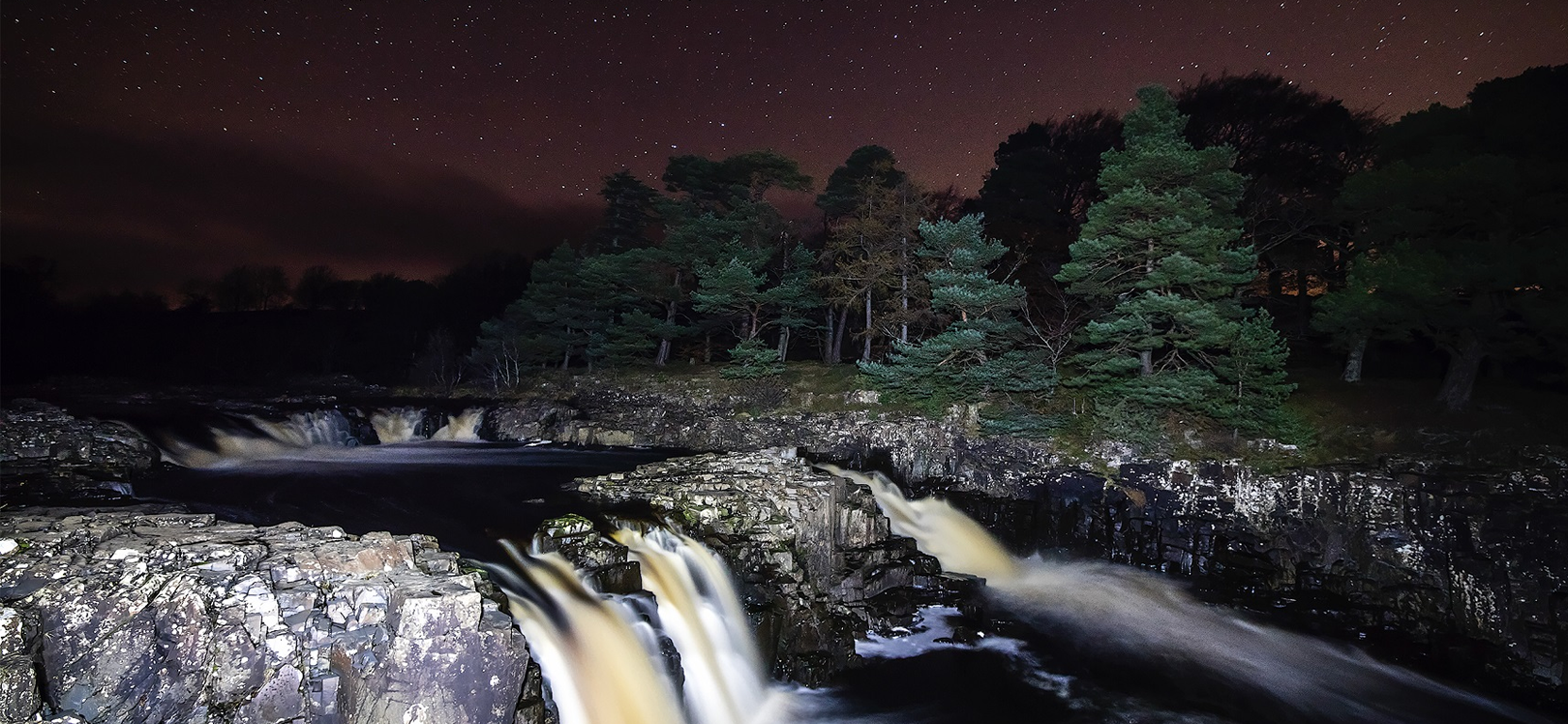Events & Training
Stargazing Guide for Tourism Businesses
The North Pennines has some of the darkest skies in England. On clear Autumn evenings the Milky Way can be seen majestically across the sky and star clusters sparkle like diamonds on black velvet.
It's a breathtaking scene that adds so much to the unspoilt character of the region. On a clear moonless night you can see 2,000 stars at any one time, compared with just a handful from urban areas.
Designations
It’s estimated that 80% of British people cannot see the Milky Way from where they live. Yet interest in stargazing has never been higher. That opens up new possibilities for tapping into the market for dark sky tourism. Because dark areas are so important, two main designation schemes have been created. The UK Dark Sky Discovery project is run by the Royal Observatory in Edinburgh and has designated over 200 sites for people to view the heavens safely, such as visitor centre and scenic car parks. In total 16 of these are the AONB. A much higher level of protection is overseen by the global International Dark Skies Association (IDA). They sanction the creation of dark sky parks and reserves, protected areas of pristine sky with lighting management plans endorsed by local authorities/national parks and a commitment to outreach and sustainable tourism. The scheme started in 2007.
IDA dark sky places in the UK include:
- Northumberland Dark Sky Park
- Exmoor Dark Sky Reserve
- Brecon Beacons Dark Sky Reserve
- Isle of Col Dark Sky Community
- Moffat Dark Sky Community
- Galloway Forest Dark Sky Park
- Elan Valley Dark Sky Park, Wales
- Snowdonia Dark Sky Reserve
- South Downs Dark Sky Reserve
- Bodmin Dark Sky Landscape
- Tomintoul and Glenlivet – Cairngorms
- Cranborne Chase AONB Reserve (provisional)
- Yorkshire Dales
- North York Moors
- Davagh Forest (Northern Ireland)
- Ynys Enlli (Bardsey Island)
The North Pennines may make an application under this scheme at some point and is certainly dark enough to qualify.
Northumberland Dark Sky Park was designated in 2013. It incorporates all of Northumberland National Park and 70% of Kielder Water and Forest Park. Astro-tourism has taken off in the region and is worth £25m annually to the regional economy.
What can you see in our skies?
Because we have less light pollution we can see much dimmer stars than from urban areas. For instance the furthest object you can see with your naked eye is the Andromeda Galaxy – a vast island of stars similar to our own Milky Way. From built up areas its very difficult to glimpse, but from our location it is visible in all its glory, looking like an elongated glow set amongst the stars.
Use binoculars and you will see the galaxy's arms stretch out on both sides from a bright central core. This amazing object is 2.5 million light years away. Meteor showers are also best viewed from dark locations. These 'shooting stars' are grains of dust from the tails of comets burning up when they enter the Earth's atmosphere.
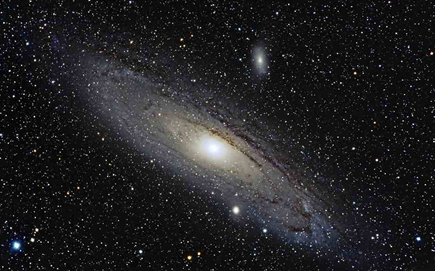
Andromeda Galaxy
When to observe?
During mid-summer nights don't get properly dark so you don’t see many stars. During the rest of the year the only obstacles are the weather and the moon. The latter is a wonderful object to view with a telescope or binoculars, but its light does wash out the fainter stars. The starriest view of the heavens comes when the moon is out of the way – the so-called new moon period. Most diaries will tell you when this is. But of course the moon itself is an attraction. The best time to view it is when it is in a partial phase, for instance first quarter. Trace the line between night and day on the lunar surface and you will be rewarded with views of craters and mountain chains cast into sharp relief by sunlight causing shadows. Planets are all unaffected by the moon's presence and Jupiter, Saturn, Venus and Mars can all be observed when above the horizon. Advise potential customers accordingly. Our view of the stars also changes through the year as the Earth orbits the Sun so there's always something new to see. For example the Milky Way is best observed when it is high in the sky at a convenient time – that occurs during Autumn evenings. Some of the most sparkling skies occur in the winter when the magnificent constellation of Orion hovers above the southern horizon well before midnight. Spring is a good time to see brighter galaxies.

Noctilucent clouds over the North Pennines. Summer skies can be beautiful – but you'll see fewer stars.
Noctilucent clouds over the North Pennines. Summer skies can be beautiful – but you'll see fewer stars.
How can your business take advantage?
We have some of England's darkest night skies so trumpet this in your marketing. Make full use of social media like Facebook, Instagram, Twitter, along with websites, leaflets and adverts. Images of the night-sky should also be used. A picture really is worth a thousand words. Encourage feedback from your visitors to generate a buzz. Here are some suggested key messages to use in your marketing:
Star quality!
- The North Pennines is one of England's darkest areas and great by night and day.
- We see thousands of stars overhead compared with a handful from towns and cities.
- View the Milky Way in all its glory, along with distant galaxies, sparkling star clusters and even the Northern Lights.
- Our dark skies are also good for nocturnal wildlife like owls and moths.
Make yourself dark sky friendly. If you have external lighting ensure that is is well shielded so the beam points down. There are commercially available units which do just this. Only use as much light as you need and consider whether you need external lighting at all. This will help reduce light pollution, save money and preserve our view of the stars. LED floodlights have become a big problem in both urban and rural areas. They shine a harsh white/blue light that is painful to look at, harms nocturnal wildlife and disrupts human sleep patters. But well chosen LED lights can be cheap to run and kind on the environment. Only choose low power fixtures with a temperature (equates to colour) of less than 3,000K – this will produce a warm coloured light. Amber light is better still. A motion sensor is a sensible option – why have a light on in the middle of the night if you don’t need it? If you already have more powerful units you can mitigate some of their negative effects by pointing them directly down and using only when needed. Remember even a modest unit may emit 12 times more illumination than a small lighthouse. The effect on the landscape is out of all proportion to people’s needs and significantly degrades the environment.
Browse what qualified as a dark sky friendly lighting.
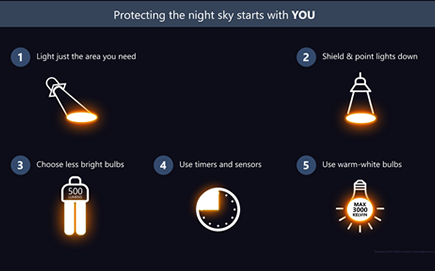
Know the market
There are two kinds of visitors attracted by the prospect of dark skies:
- Novices with little knowledge of the heavens, but intrigued to find out more. These will be
- the majority.
- More experienced astronomers who may have their own gear and want to escape their
- light polluted homes to view under a dark sky.
Provide equipment
You can help visitors by providing binoculars, either in rooms or available to borrow. These days you do not have to spend a fortune to get decent quality. Very easy to use, light-weight and providing a wide field of view, they offer wonderful views of the Milky Way, star clusters, bright galaxies and even the
moons of Jupiter! The best sizes are a 10 x 50 or 7 x 50. The first number refers to the magnification and the second the diameter of the two lenses which the collect light. Larger binoculars will show you more, but they become heavier and are more difficult to use without a tripod.

The binoculars shown are Helios Naturesport Plus 10 x 50, which retail for about £89. Opticron also do a good budget option - Opticron Adventurer 10x50 T WP Binocular. Cost currently is £84. In my tests they are slightly better than the Helios, but not by much.
But what about telescopes. Should you get one for guests to use? Well they do give better views of planets and star clusters, but the downside is that they are more difficult to use. They have a narrower field of view so finding objects can be tough until you get the hang of it.
If you do opt to buy a scope keep it simple and portable. You can spend hundreds (even thousands) of pounds on hi-tech instruments which automatically slew to objects and track the stars as they move across the sky. But there is a learning curve involved and what we want to do is make the sky accessible to novices.
So a good option would be a very simple wide field refractor type telescopes (which uses a lens to collect light) on an equally simple but stable tripod and mount called an Alt-Az mount – which allows the telescope to be pushed up and down and left and right. You don't need to spend a fortune.
The telescope illustrated (Startravel 102) retails for about £259, with an AZ3 mount and tripod. Comes complete so you can get started straight away. It will not automatically track the stars – you have to push it – but it is very easy to use and offers nice views. You will, for instance, be able to spy the rings of Saturn, mountain chains on the moon and brighter nebula where stars are born. This kind of set-up is pretty much maintenance free.
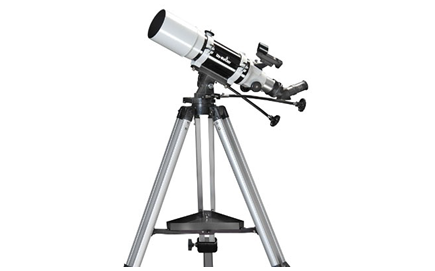
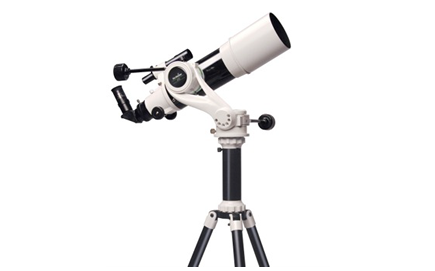
The tripod is functional and if you feel flushed with cash the same tube can be mounted on a nice AZ5 mount for £389
A more powerful, but also simple to use telescope is a reflector on a Dobsonian mount. Instead of using a lens to collect the light, it uses a mirror. You look through the telescope at the top. Because mirrors are cheaper to make than lenses, you get more telescope for your money. Again this kind of set-up will not automatically track the stars so you move it manually up and down and left and right. The model shown is called a Skyliner 200 – it costs about £380, but offers four times the light gathering power of the refractor above. To get the best from it you will need to learn a simple procedure called collimation which ensures optics are well aligned to provide good views. They are also more bulky than smaller telescopes. But if you want bang for buck then this is a good choice.

Another similar option made in Taiwan is the StellaLyra 8" Dobsonian (£449). I’d personally go for this one, gets a good write up.
Red torches
Preserving night vision is important when viewing the stars – you see so much more when your eyes are attuned to low light levels. It takes 20 minutes for your eyes to get properly adjusted, but white light destroys this in seconds and means you have to start again. However, red light can be used without much of a detrimental effect. So think about providing guests with LED headlamps which have a red option on them. They are great for reading star maps and also offer security when walking in the dark. They can be found online for around £10. Energizer do a nice one (225 lumens model) for £12.

Other ideas
If you have a garden try to keep an area free from white light so guests can stargaze, or even set up their own equipment.
Reclining chairs are also great to relax and gaze skywards in comfort and are the perfect way to watch meteor showers without getting a sore neck. You soon get cold when you are stood outside in the night, even in the summer, so provide blankets and advise people to dress in layers. You could also provide woollen mittens and a flask.
Dark sky friendly schemes
Visit County Durham run an accreditation scheme where you can apply for dark sky friendly status for your business. This will help you stand out from the crowd when people research their trip. The application procedure is straight forward, involving a check list, and designation allows you to use this logo and stand out from the competition. Copyright free imagery is available which you can use in your own promotion. This is a no-brainer so please do sign up! Contact Lucy Wearne at Lucy.Wearne@visitcountydurham.org.
Astronomical happenings
Keep your eyes peeled for big astronomical events like meteor showers. The better ones are nearly always flagged up by the national media so make sure your marketing highlights that our dark skies provide the perfect viewing location. Showers are best seen when the moon is absent, which varies from one year to the next. During good outbreaks you can expect to see as many as a couple of meteors per minute.
The best ones are the:
- Perseids 12/13 August
- Orionids 21 October
- Geminids 13/14 December
The Northern Lights are unpredictable as they are caused by an outburst of very energetic particles from the sun. Using an app will give you a few hours notice. Generally we have a handful of displays every year visible from the North Pennines. We are amongst the best places in England to view them. We are seeing more displays at the moment because the sun is very active. That will continue to be the case for the next year or so.
Try this app: Aurora Watch UK. It gives you a heads up if a display is likely at your location.
Other Apps
Google Skymap – identifies the stars using GPS when you hold up the phone to the sky.
Star Walk 2 – similar to the above, but IoS platform.
Meteor Shower Calendar – tells you which showers are due and whether the moon will spoil the show.
Sky Safari – comes in various flavours and is a superior planetarium style programme. Very popular with astronomers of all levels.
ISS Detector and ISS Spotter – both will alert you when the ISS is due to pass overhead.
APT Darkness Clock - When is the sky due to be completely dark without moonlight? This app will tell you.
Useful resources
Stellarium – interactive planetarium programme. Easy to use and shows the night sky realistically. Free and available for Windows, Mac and smartdevices
First Light Optics Exeter based, very reliable astro retailer. Carry a big stock.
Tring Astronomy Reliable astro retailer, competitive on price.
UK Astro Buy and Sell – well used by astronomers to buy and sell used gear. A great place to shop and make savings. Well looked after astronomical equipment can last a lifetime.
My twitter feed offers a diet of astronomical happenings and news - @RichDarn1. Feel free to retweet. I’ve also got a WordPress site with useful information. Don’t hesitate to contact me if you want further advice! More than happy to help.
Richard Darn - richard@richarddarn.com
Mobile: 07753670038

